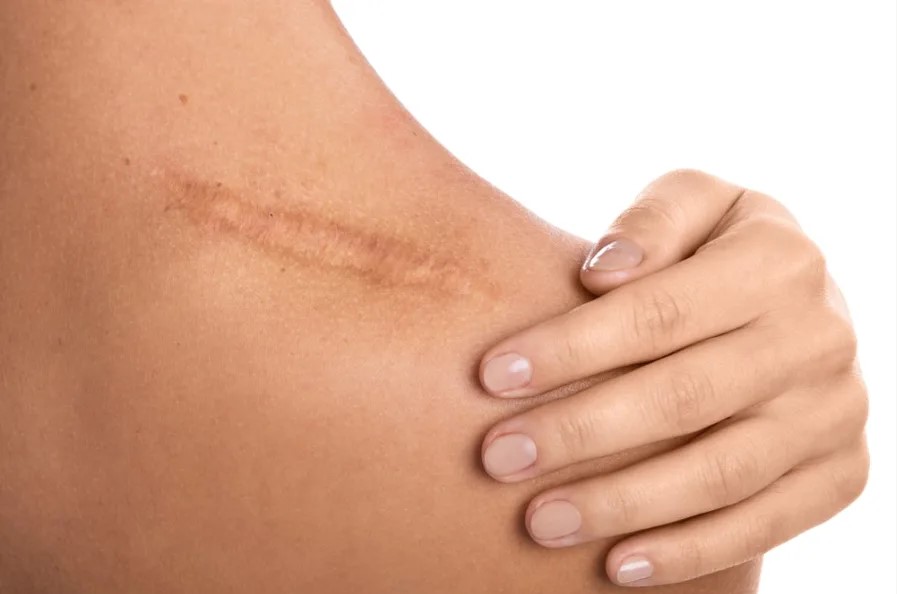Dermabrasion Might Be the Scar Treatment You’ve Been Looking For
Printed with permission from www.aedit.com!
Dermabrasion is an increasingly popular, and successful, procedure to minimize the look of scars. We spoke to dermatologist Dr. Jeanette Black to find out why.
If you could permanently remove scars from your body, would you? There are numerous cosmetic treatments for scars and we’re constantly finding new ways to reduce the appearance of our scars or get rid of them altogether. And some are more permanent than others.
Picking the right scar treatment comes down to what results you are looking for and the type of scar you have. For example, if you’re prone to acne scars you know they are much more permanent than an acne mark, which is a lighter skin blemish. The procedure used on deep scars is more involved than a treatment used for lighter marks on your body.
You’ll also have to consider the size of your scar and where it’s located on your body. Larger scars will require longer treatment times and may require more than one session. Before you commit to a procedure, speak to a board-certified dermatologist or cosmetic surgeon to ensure it’s the most efficient and effective scar treatment for your skin and body.
You may have heard of microdermabrasion, which is an increasingly popular non-invasive treatment that removes dead skin and debris, while effectively stimulating collagen production and increasing your natural healing processes. Beverly Hills dermatologist, Jeanette Black, MD, describes microdermabrasion as “an exfoliating treatment which can help give skin a smoother, brighter complexion. Microdermabrasion results are temporary, but the procedure can be easily done regularly without downtime or pain.”
Microdermabrasion is available at most certified skin clinics. There are also over-the-counter microdermabrasion treatments, but they aren’t as effective as professional versions.
If you feel like you need something a bit more long-term, dermabrasion is a treatment that is not only used to treat different types of scars, but also dark spots, wrinkles, sun damage, precancerous skin patches and growths, and uneven pigmentation. Dermabrasion can also be used for raised scars, such as hypertrophic and keloid scars. It is a “medical grade resurfacing procedure which can potentially provide very dramatic results,” says Dr. Black.
Dermabrasion is the triple threat of skin treatments. The procedure is performed with a rotating instrument that exfoliates the skin and effectively removes the outer, damaged layers to unveil smoother looking skin and a more youthful appearance beneath. Dermabrasion can be used for various types of scars on your body, such as chicken pox marks, scarring from an accident or procedure, or scarring from a previous skin condition. The procedure can take between a few minutes to an hour and a half depending on the size of the area being treated, where the scar is on your body, and the depth of the scar. These factors also indicate how many sittings you’ll require to achieve your desired results.
We spoke to Jane* about her previous dermabrasion experience. She opted for dermabrasion to treat the minor scarring, uneven skin tone, and minor pigmentation she experienced after pregnancy. “I just needed one treatment and overall, I was happy with it,” she says. “I went to a good, reputable place that was recommended to me by other people who had it done and I think that’s key. I felt that my skin tone was more even and a lot brighter and there was an improvement in my overall appearance.”
It’s important to keep in mind the severity of your scarring will affect the success of your dermabrasion procedure and may require more than one treatment. Similarly, if you have an active skin condition, such as body acne or chicken pox, dermabrasion has the potential to spread infection and is not recommended for you until your condition clears.
Most people are eligible for dermabrasion, but the healing process is different for everyone. Older people generally take longer to heal, for instance, and the color of your skin can also impact the success of the procedure. Darker skin tones can experience permanent discolouration or blotchy skin following the procedure. It’s important you discuss the outcome with your dermatologist prior to your procedure.
During the healing process be prepared to experience red and swollen skin, a burning or tingling sensation in the treated area, the formation of scabs over the treated skin, and itchiness where the new layers of skin are growing. Swelling of the treated area will begin to decrease over a few days, but can take up to weeks or even months to return to its normal state. And like any invasive procedure, a follow-up appointment with your provider is likely.
*Patient’s name has been changed.
Derma Bright Clinic offers a number of skincare treatments including microdermabrasion, Alex Peels, Alumier peels and more. Visit www.dermabrightclinic.com to find out more!

